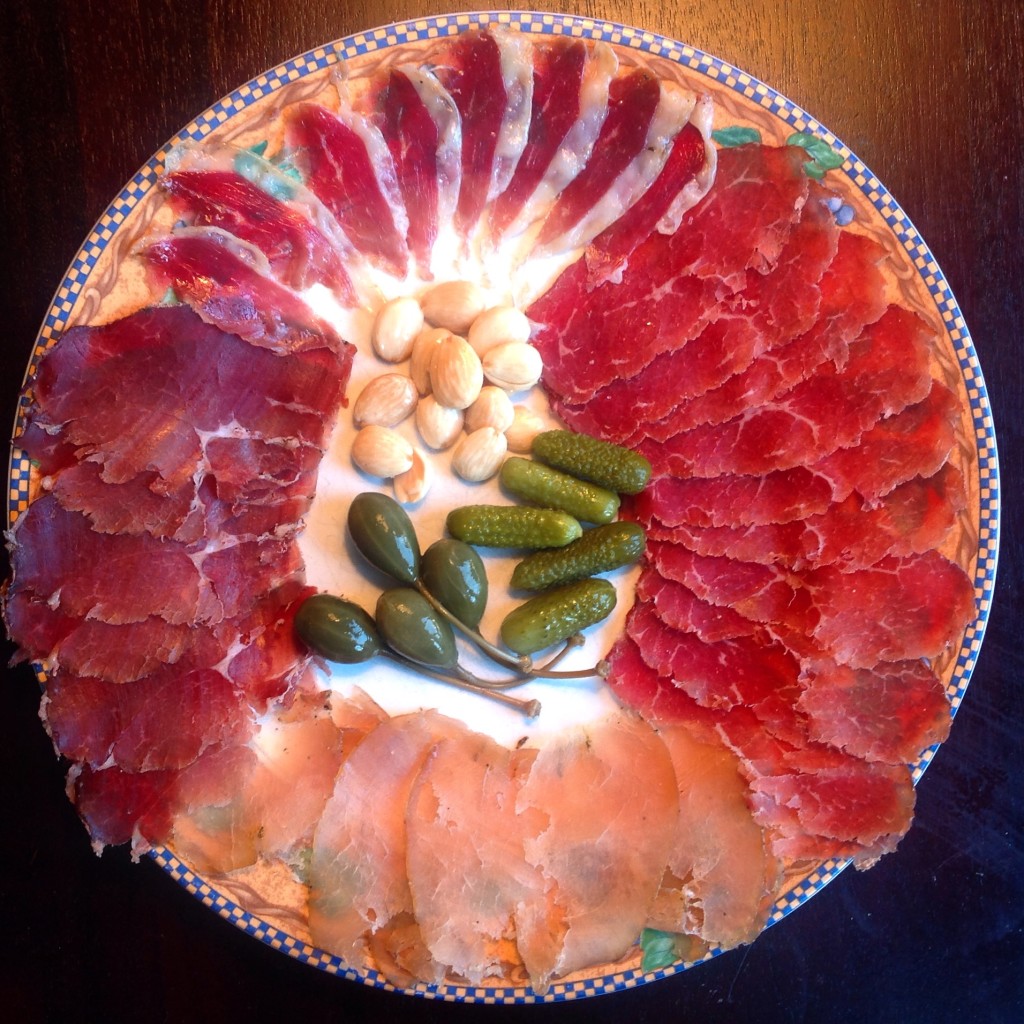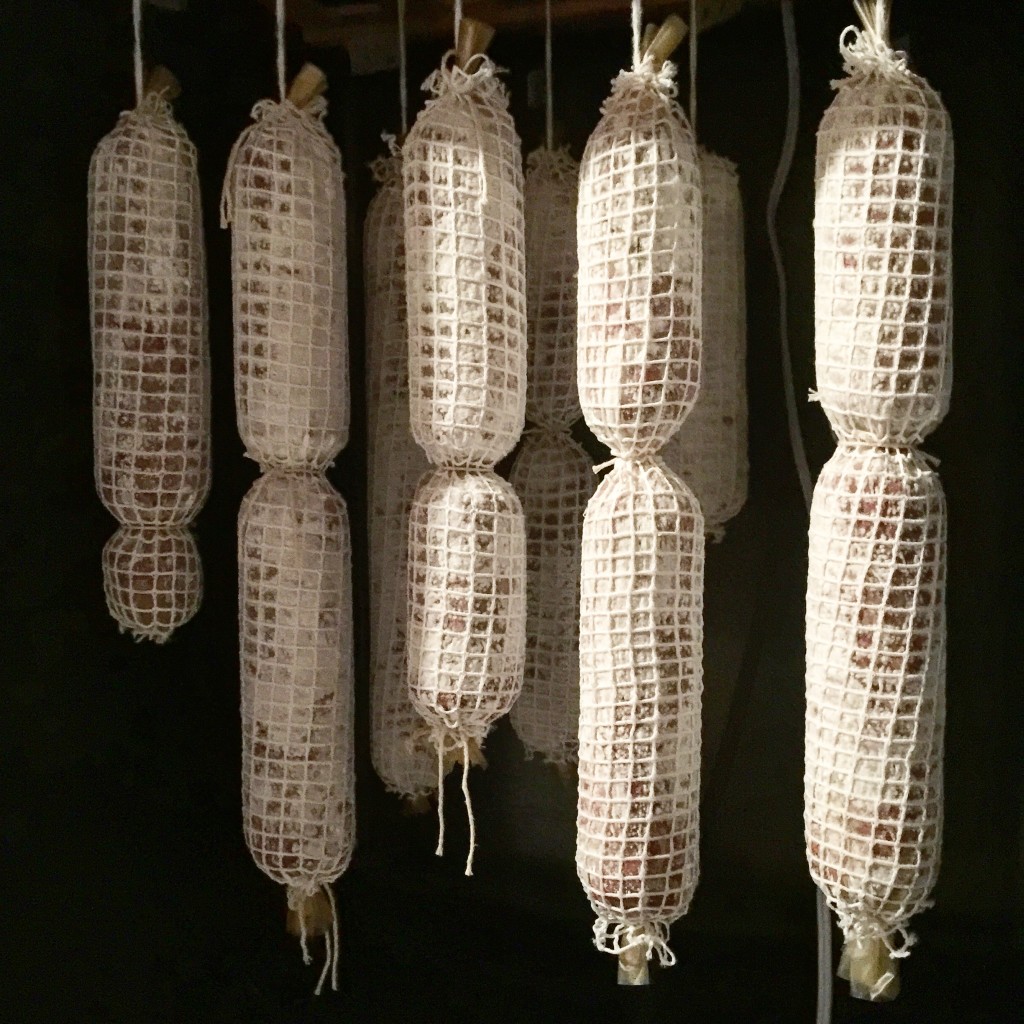Introduction
*Note: For information on specific projects, see the “Recipes” page under the “Charcuterie” heading.
The process of making cured meats at home is both an art and a science. We are able to draw on historical practices in order to guide our modern day experiments. Historically, the process of making cured meats was like an art, the masters of which used information and processes that were passed down the generations. Today, we are able to use modern scientific knowledge and techniques to expand the boundaries of what is made and enjoyed.
In my culinary journey, I try to use my scientific knowledge to inform my decision making process. I make hypotheses about what will happen, and use my kitchen as a test lab. Not everything I try works; there are often failures, which serve to teach me more about the processes I am investigating. These failures only help me to get closer to a superior end product, and must be considered part of the process.
Here, I will try to synthesize the knowledge that I have discovered and create a basic guideline for curing meat. Specific recipes will be described in more details in their own individual posts, but this page will serve as a general reference for meat curing.
Whole Muscle Cures
Whole muscle cures are exactly what they sound like; cured meat products that are made out of an entire muscle from an animal. Whole muscle cures can be made with any muscle, from any animal. There are well known whole muscle cures and obscure ones.
The basic process for whole muscle meat curing involves:
Curing (2-3 weeks): This is the initial stage where the meat is packed with salt and spices. The process of osmosis and diffusion plays an important role in this stage. The cure mixture diffuses from the high outside concentration into the low concentration inside the meat, while water is attracted to the higher osmotic gradient that is found outside the meat.
Excess cure: Excess curing is an older curing method that is exactly what it sounds like. The meat is packed into salt and allowed to stay there for a number of days. It is a tried and true method, but can result in overly salted and spiced meat.
Equilibrium cure: Equilibrium curing is a newer curing method, which uses the scientifically determined minimum safe values for salt and nitrates. The cure is added to the meat at the desired concentrations, and the meat is allowed to equalize in the cure for a number of weeks. One of the benefits of using the equilibrium curing method is that you will arrive at your exact desired spice and salt level, without over saturating your meat product. I prefer the equilibrium method, and use it almost exclusively in my projects.
Aging (3 weeks + depending on the project): After the meat has sat in the cure for the appropriate amount of time, it is taken out of the cure, the excess cure is washed off, the meat is dried, put into a casing, and hung in a curing chamber. The creation of a curing chamber has been discussed previously, but the salient details are that it creates an environment that is around 12C/54F and 75% relative humidity (RH). The temperature is important to allow for beneficial bacteria and mold growth, while preventing the meat from spoiling. The humidity is important to allow to for the slow diffusion of water out of the meat, over a longer period of time. If the humidity is not high enough, the meat can develop something called case hardening. Case hardening is when the outside of the meat dries out, which prevents the water from the inside to escape. This leaves the meat in the center raw and stalls water weigh loss over time. If the humidity is too high, it can encourage the growth of non-beneficial molds and slow down weight loss to a halt.
There are a number of ways to determine when a meat product is done, but the simplest one is to track the water weight loss over time in the curing chamber. For whole muscle cures, I have found that 30% weight loss creates an optimal product in most cases (there will be variation based on how much fat is in the cut, the more fat, the less water it will lose).
Cold smoking (4 hours+): Cold smoking is not a necessary step to finish a cured meat product, but is always an option. A cold smoking setup will keep the temperature below 30C/86F while still imparting a smoky flavor to the cured product. It is important to keep the temperature below this point because as soon as you start hot smoking the product, it begins to cook in the traditional manner, which will erase the complex flavors brought out by the slow process of curing.
Types of Whole Muscle Cures
Bresaola is a whole muscle cure, usually made with an eye round roast, a common and cheap cut of beef. Traditionally, bresaola was made out of the eye round roast because it was not one of the prime cuts of beef. The eye round roast does not have much fat, and is hard to cook in a traditional manner in a way that is tasty. These traits were perfect for curing in the traditional manner. However, while the use of beef fat has been avoided in traditional charcuterie, it need not be! Beef fat tends to go rancid before pork fat does, so in the days before refrigeration and the common use of nitrates in curing, it was just safer and made better sense not to increase beef fat when curing meat. Today however, there is nothing wrong with curing beef fat, in fact it can yield some of the most delightful products!
Some common cuts that are used for bresaola besides from the eye round roast are the more expensive tenderloin roast, the more marbled bottom round roast, and the sinfully fatty ribeye roast. However, there are no limits to be what can be done, so experimentations should be encouraged.
While bresaola is usually a term reserved for cured beef muscles, it can also be used to refer to cured turkey products. Bresaola di tacchino or turkey bresaola can be made with turkey breasts. This is often touted as a “healthy” alternative to other cured meat products in Italy, and is consumed by health conscious athletic Italians.
Prosciutto is a general term for a whole cured meat made from the leg of an animal. It is traditionally made from pigs, but can be made from other animals as well. Prosciutto is made bone in generally, but can be butchered in order to create two cuts that are bone out, fiocco and culatello. Capocollo is a term for a cured meat product made out of a muscle on the top of the neck of a pig. Similar iterations can be made from other animals as well.
Lamb prosciutto or prosciutto d’agnello is a lamb cured meat product, traditionally made with a leg of lamb. It can be cured with the bone or without the bone, depending on how you want to cut the final product. A lamb prosciutto cured with the bone in is best hand cut with a thin, sharp knife while a lamb prosciutto cured without the bone can be more easily sliced on a deli slicer. Again, as with the bresaola discussed above, any cut of the lamb can be used to make this product, a common variation uses a lamb shoulder roast which may be called a capocollo d’agnello.
Goat prosciutto or violino d’capra is a version of prosciutto made with goat. Because goat is a smaller, lean meat, this prosciutto tends to be a quick one to cure. When it is cured, it is relatively small and resembles a violin. When cutting the meat with a knife, it is like one is “playing the violin.”
Duck prosciutto or prosciutto d’anatra is one of the so called “entry level” cured meat products. Duck prosciutto is made from duck breasts, which are relatively small. Because of the small size of a duck breast, duck prosciutto can be aged in as little as 3 weeks.
In addition to bresaola and prosciutto, cured fish is an interesting form of charcuterie. Fish can be cured in a similar to manner to the aforementioned meat. An example of a cured fish is tuna prosciutto, also called mojama or mosciame. Mosciame is made from the loin of a tuna fish, cured and hung to dry in a curing chamber. There are a number of different methods, the more traditional methods use an excess cure and a short hanging time (in seaside villages in Sicily it is hung outside with the laundry), while more modern methods use equilibrium curing with longer hang time at higher humidity.
Salami
Salami is a cured meat product made by grinding up meat, mixing it with salt and spices, stuffing it into a casing, allowing it to ferment, and then hanging it in a curing chamber at ~12C/54F and 75% RH until it loses a certain percentage of its initial weight (I have found ~40% to be ideal for salami).
Salami can be made from any meat, but is traditionally made from pork. Salami is made with a combination of meat and fat, usually at least 30% fat in order to get the consistency of the salami right. Even non-pork salami often uses pork fat due to its ideal properties. However, brisket fat is often a good alternative for pork fat, and can be used to make salami that is pork free.
There are a number of different types and methods of salami making which will be discussed separately in each individual salami post.
Wrap Up Thoughts
Overall, meat curing is a fun adventure to embark upon. While many first attempts are successful, it takes a lot of research and trial and error to perfect the process. Creating an optimal product takes troubleshooting your experiences, and making educated guesses as to what you need to fix to make your product better. Meat curing truly is an art and a science, and will reward those who take the time and effort to excel at it.
*Safety Note: It is important to make sure that you are working with clean surfaces and tools at all times. It is important to follow safety guidelines in terms of salt and nitrate percentages. Joining a community of meat curers is one way to idiot check any safety blunders you may run into. And when in doubt, trust your gut; if something doesn’t seem right, it may be painful, but smart, to throw out the product and start again.

